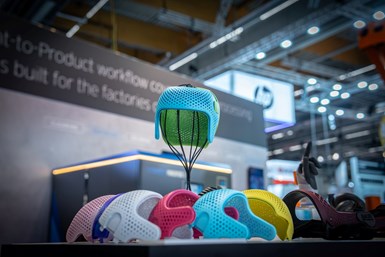Collaboration Brings Together HP’s 3D Printing Technology and DyeMansion’s Postprocessing Workflows
Partnership means HP will market DyeMansion’s postprocessing workflows as a preferred solution for customers to achieve large-scale production of final parts.
Colorful finished cranial helmets produced with HP MJF technology at Formnext 2023. Source: DyeMansion
HP and DyeMansion have formalized a strategic collaboration, bringing together HP’s advanced 3D printing technology and DyeMansion’s postprocessing workflows. HP will market DyeMansion’s postprocessing workflows as a preferred solution for customers to achieve large-scale production of final parts.
Together, the companies will focus on delivering high-quality, scalable and eco-friendly solutions in additive manufacturing (AM). The companies also say they will tackle joint market analysis and provide end-to-end solutions that seamlessly integrate into users’ operations, unlocking new applications and offering mutual support and advice.
The collaboration aims to simplify access to comprehensive solutions for AM users worldwide. The collaboration’s roots trace back to significant moments of innovation and collaboration as well as a joint global customer and reseller base. This includes the May 2020 introduction of the first-ever color range for gray parts produced with HP Multi Jet Fusion technology, marking the beginning of the collaboration. In November 2022, the companies expanded the color range to include white parts, enhancing aesthetic and functional customization in 3D printing.
In September 2023, the companies made a joint presentation at AOPA, the leading event for the O&P industry in the U.S. And, in November 2023, the two launched the AM I Navigator — developed with input from HP, DyeMansion and other industry leaders like Siemens — to guide users through the AM process.
Both companies say they are excited to extend their collaboration at key industry events in 2024, including Formnext and Rapid + TCT, showcasing the synergies between both technologies and a joint vision for the future of manufacturing.
“The formalization of the strategic collaboration with DyeMansion represents a pivotal moment in our journey together,” says François Minec, HP’s global head of 3D Polymers. “It combines our leading 3D printing technology with DyeMansion’s detailed postprocessing to set new standards in the production of 3D printed parts.”
The close cooperation between printer manufacturers and postprocessing technology providers makes it possible to develop useful and market-oriented solutions for AM users worldwide. “We at DyeMansion and HP have already internalized this very well,” says Felix Ewald, DyeMansion CEO and Co-founder. “I am very pleased about this and look forward to our upcoming joint activities.”
Related Content
-
3D Printed Lattice for Mars Sample Return Crash Landing: The Cool Parts Show Bonus
NASA Jet Propulsion Laboratory employs laser powder bed fusion additive manufacturing plus chemical etching to create strong, lightweight lattice structures optimized to protect rock samples from Mars during their violent arrival on earth.
-
Possibilities From Electroplating 3D Printed Plastic Parts
Adding layers of nickel or copper to 3D printed polymer can impart desired properties such as electrical conductivity, EMI shielding, abrasion resistance and improved strength — approaching and even exceeding 3D printed metal, according to RePliForm.
-
How Electroplating Works for Polymer 3D Printed Parts
Baltimore-based RePliForm specializes in electroplating of 3D printed polymer parts for functional applications. This video explores how the process works, and potential benefits and uses for this technique.















